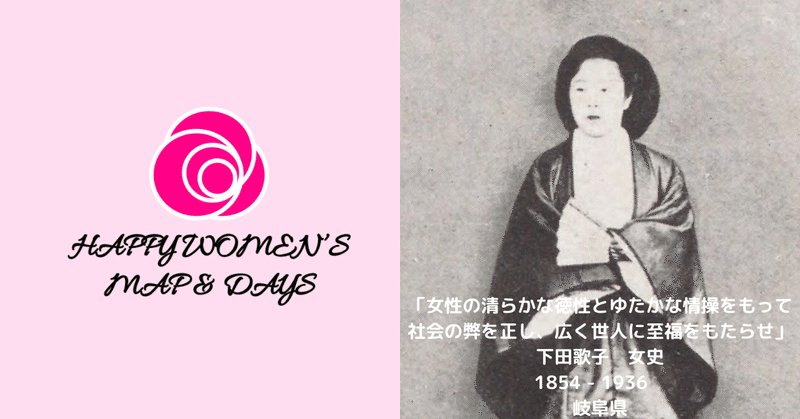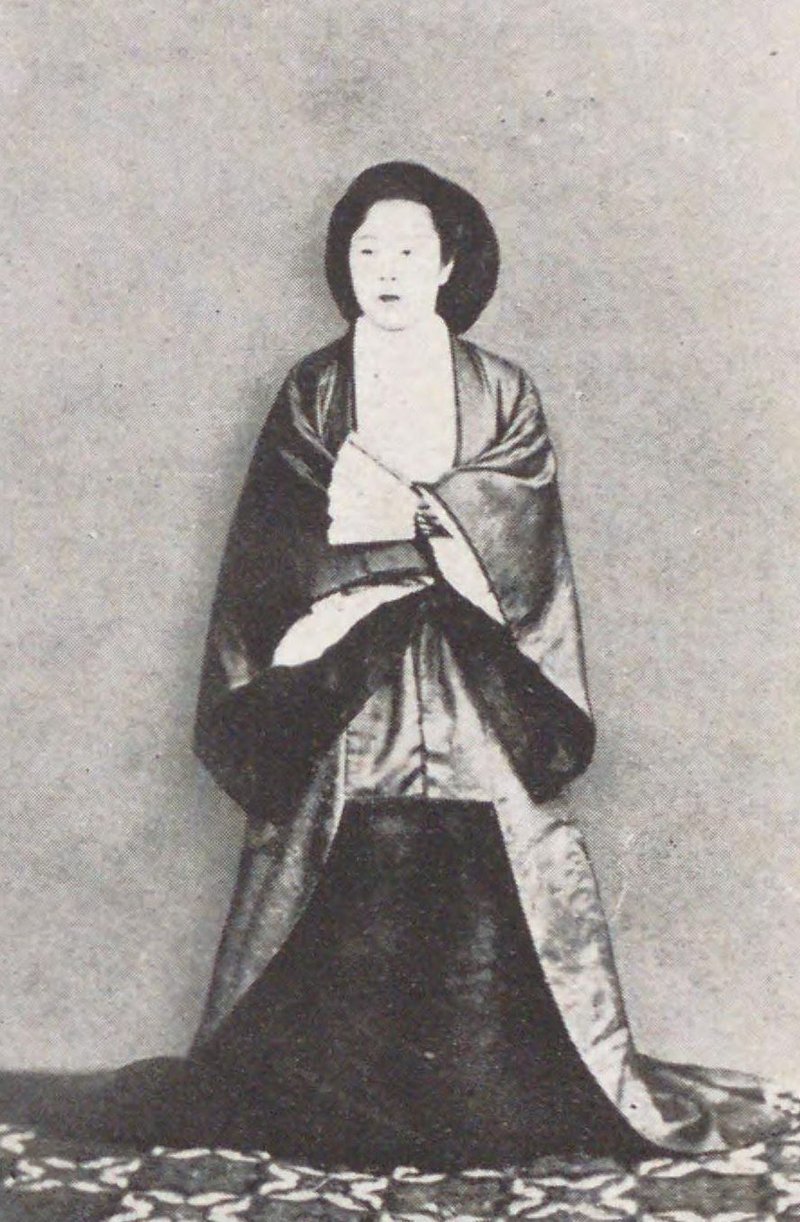
Happy Women's Map 岐阜県 日本女子教育の先覚者 下田 歌子 女史

「女性の清らかな徳性とゆたかな情操をもって社会の弊を正し、広く世人に至福をもたらせ」
"With their pure virtues and rich emotions, women can rectify the ills of society and bring happiness to people in the world."
下田歌子 女史
Ms. Utako Shimoda
1854 - 1936
岐阜県恵那市 生誕
Born in Enashi-city, Gifu-ken
下田歌子女史は日本の女子教育の先覚者です。彼女は明治天皇の皇后に明治の紫式部と称えられ、華族女学校の教授と学監に就任。さらに女性の自立自営をめざして、一般女子のための私立実践女学校(現在の実践女子大学)また女子工芸学校、さらに勤労女子のための夜間学校を設立。さらに学校に通うことのできない女子に対する通信教育事業を開始。その後も裁縫学校や夜間学校を各地に設立するなど、毀誉褒貶に動じることなく新しい時代の女子教育に一生を捧げました。女学生用制服の海老茶袴、メイポールダンス、自転車、体育を取り入れました。
Ms. UtaKo Shimoda is a pioneer in women's education in Japan. She was hailed as the "Murasaki Shikibu of the Meiji Era" and served as a professor and superintendent at a noblewomen's school. Furthermore, she aimed to promote women's independence and self-employment by establishing the private Jissen Women's School (now known as Jissen Women's University) and the Women's Craft School. She also founded a night school for working women and started a correspondence education program for girls who couldn't attend school. Undeterred by praise or criticism, she dedicated her life to modernizing women's education. She incorporated maroon hakama, Maypole dancing, bicycles, and physical education into the female students' uniforms.
*******
下田歌子女史は鉐(せき)として、祖母また母から読み書きを習い幼いときから和歌や俳句・漢詩・日本画に才能を発揮します。祖父また父は幕末の進歩的な学者ゆえ幕府また藩の咎めを受け蟄居謹慎でした。時代は江戸から明治へと移り、鉐の祖父と父は上京して明治政府に出仕、家族を東京に呼び寄せます。鉐は祖父また父はじめ八田知紀など優れた師の元で和歌・漢学・古典その他の教えを受けます。18歳の鉐は八田知紀その他多くの人々からの推挙を受け女官に抜擢され宮中へ出仕します。皇后・美子から寵愛され「歌子」の名を賜り、 宮廷で和歌を教えるようになります。25歳の歌子は周囲から惜しまれつつ宮中を辞し、剣客として知られる下田猛雄と結婚します。夫はまもなく胃病を患い、長く病床の人となってしまいます。彼女は看病のかたわら自宅で上流の子女のための『桃夭女塾』を開講。当時の明治政府高官の妻の多くは芸妓や酌婦であり、明治政府高官の強い要望のもと、正統な学問のない彼女らに古典の講義や作歌を教えました。夫が病死した同年に、近代日本にふさわしい上流女子教育をという皇后の令旨により華族女学校(後の学習院女学部)が開設されると、30歳の歌子は塾の実績と皇后の推薦により学校開設と同時に教授に任ぜられ、翌年には学監として、以後退官まで歴代校長を補佐し、学校運営と教育に従事ます。39歳の下田歌子は明治天皇の皇女ご教育係の内命を受け、2年間にわたって欧米諸国の上流階級のみならず諸階級の女子学校教育また家庭教育のありかたをつぶさに見学しました。帰国後44歳の歌子は帝国婦人協会を設立。これまで上流階級に偏っていた婦人団体を広く全国的な組織とし、一般女に教養と自活の機会を授け、精神的自立・地位向上・生活改善をはかるべく奮闘します。翌年、機関誌「日本婦人」創刊。さらに中流階級の婦女子育成を目的として実践女学校(現在の実践女子学園)および女子工芸学校を創立。さらに、裁縫伝習所(現在の新潟青陵学園)、順心女学校(現在の順心広尾学園)、明徳女学校、淡海女子実務学校(現在の淡海書道文化専門学校)、愛国夜間女学校などの設立に携わり、校長を兼任。これらの学校は、大半が経済的に恵まれない女子や、一般女子のために進学しやすいよう企画され、授業料も低額でした。さらに勉学の機会に恵まれない女子を対象に大日本実修女学会を設立し、「実修女学講義録」を刊行するなど、現在の通信教育に似た事業も行いました。また、初等教育で使用する教科書として『国文教科書読本』(全8巻)を、日本で初めての家政学の教科書として『家政学』(全2巻)『新選家政学』(全2巻)を編纂・刊行します。歌子の講義は国文学、漢文学、家政学のいずれも深い学識に裏づけられユニーク、中でも源氏物語の講義は早稲田大学の坪内逍遙のシェークスピア講義と並ぶ名講義と言われています。
UtaKo Shimoda, Seki had a talent for poetry, haiku, Chinese poetry, and Japanese painting, having learned reading and writing from her grandmother and mother since she was young. Her grandfather and father, both progressive scholars of the late Edo period, faced censure and house arrest from the shogunate and clan. As the era transitioned from the Edo period to the Meiji period, her grandfather and father moved to Tokyo and served the Meiji government, bringing the family with them. Under the guidance of her grandfather, father, and other exceptional teachers like Tominaga Nakamoto, Uta Ko Shimoda received education in waka (Japanese poetry), Chinese learning, classics, and other subjects. At the age of 25, she was recommended by many, including Tominaga Nakamoto, and was appointed as a female attendant and began serving at the Imperial Court. Empress Meiko bestowed her with the name "Utako" and she began teaching waka at the court. At the age of 30, she left the Imperial Court, much to the regret of those around her, and married Shimoda Takeo, a swordsman. Shortly after, he fell ill with a stomach ailment and became bedridden for a long time. While nursing his illness, she opened the "Touyou Women's Academy" for upper-class girls at her home. At that time, many wives of high-ranking officials in the Meiji government were geisha or maidservants. Under strong requests from these officials, she taught classics and waka to these women, who lacked formal education. In the same year her husband passed away, the Empress issued an order for the establishment of the noblewomen's school (later becoming Gakushuin Women's College), which aimed to provide upper-class women's education suitable for modern Japan. At the age of 30, UtaKo Shimoda was appointed as a professor upon the school's opening based on her academy's achievements and the Empress's recommendation. The following year, she became the superintendent and assisted successive principals until her retirement, engaging in the school's operation and education. At the age of 39, she was appointed as the teacher of Imperial Princesses for the education of Emperor Meiji's daughters. She traveled to Europe and various countries in the United States for two years to observe the state of advanced women's education among upper-class and other social classes as well as home education. Upon her return to Japan at the age of 44, Utako established the "Teikoku Fujin Kyokai" (Imperial Women's Association). She transformed women's organizations, which had been mainly limited to the upper class, into a widely spread national organization that provided intellectual and self-sufficiency opportunities to women of all social classes, aiming for their spiritual independence, status improvement, and better living conditions. The following year, she launched the magazine "Nihon Fujin" (Japanese Women). Additionally, with the aim of cultivating middle-class women, she established the Jissen Women's School (now Jissen Women's Academy) and the Women's Craft School. She also contributed to the establishment of the Sewing Training School (now Niigata Seiryou Gakuen), the Junshin Women's School (now Junshin Hiroo Gakuen), the Meitoku Women's School, the Tamami Women's Practical School (now Tamami Shodou Bunka Senmon Gakko), and the Aikoku Night Women's School, among others, and served as the principal at these schools. These schools were designed for economically disadvantaged girls and general girls to pursue higher education, and the tuition fees were kept low. Furthermore, she established the "Dai Nippon Jisshuu Fujin Kai" (Great Japan Practical Women's Association) for girls without educational opportunities and published "Jisshuu Fujin Kougiroku" (Lecture Notes for Practical Women) to provide services similar to modern-day correspondence education. Moreover, she compiled and published the "Kokubun Kyoukasho Dokuhon" (National Language Textbook Reader, 8 volumes) as a textbook for primary education, and "Kasei Gaku" (Housekeeping Studies, 2 volumes) and "Shinsen Kasei Gaku" (Newly Selected Housekeeping Studies, 2 volumes) as the first textbooks for home economics in Japan. UtaKo's lectures in Japanese literature, Chinese literature, and home economics were all supported by profound knowledge and were unique. Among them, her lectures on "The Tale of Genji" are said to be comparable to Waseda University's Tsubouchi Shoyo's Shakespeare lectures, known as outstanding lectures. Even in her later years, as her illness grew severe, she would come to the lecture hall in a wheelchair to deliver speeches.
-実践女子大学香雪記念館 Jissen Women's University Kosetsu Memorial Museum
Share Your Love and Happy Women's Story!
あなたを元気にする女性の逸話をお寄せください!
Share your story of a woman that inspires you!
この記事が気に入ったらサポートをしてみませんか?
